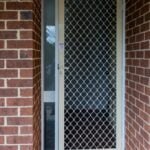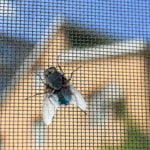The sun is setting, casting a warm glow over your backyard. You want to enjoy the fresh air, but the thought of mosquitos and flies invading your home makes you hesitate. That’s where sliding door fly screens come in, acting as a barrier between you and those pesky insects while allowing you to savour the beauty of the outdoors from the comfort of your home. But with so many sizes and customization options available, choosing the right sliding door fly screen can feel like navigating a maze. Fear not, because this comprehensive guide will equip you with all the knowledge you need to make an informed decision.
What are the Standard Sizes for Sliding Door Fly Screens?
Standard Dimensions
Australia’s typical sliding door fly screen size is around 910mm x 1220mm. However, don’t fret if your door doesn’t fit this mould! Customization is the name of the game when it comes to fly screens.
Customization
Fly screens can be tailored to match your door’s dimensions perfectly. Options range from 20″ to 48″ (50 cm to 122 cm) in width and 72″ to 100″ (183 cm to 254 cm) in height. And if you have a huge sliding door, don’t worry! You can even order custom sizes with a maximum width of 2100mm, a maximum height of 3000mm, and a maximum area of 6 m².
My Peace of Mind with Sliding Door Fly Screens
Installing a sliding door fly screen last summer brought me peace of mind. As I watched tiny insects bouncing against the outside of the mesh barrier, desperate to reach my invitingly cool home, I was grateful for the protection.
I had measured the height and width precisely before ordering. At 204cm, the opening was taller than a standard screen, but customization ensured a perfect fit. Now, my screen glides smoothly along the same track as the sliding door behind it.
The aluminium frame and stainless steel mesh keep bugs of all sizes from infiltrating while allowing fresh air to flow. I can fling the screen and glass door wide open to welcome my friends without the nuisance of flies or mosquitoes.
A larger retractable enclosure on my patio keeps the whole area pest-free. The heavy-duty polyester mesh drops when I want privacy or bug protection, retracting out of sight when unnecessary. Installation was quick and straightforward with adhesive strips and screws.
Sliding door fly screens comfort me and let me fully enjoy my indoor and outdoor living spaces. I appreciate how a customized solution solved my exact needs. As I relax bug-free on my patio this summer, I’m thankful for this simple addition that makes such a difference.
How to Measure Your Door for a Sliding Fly Screen?

Before you embark on your fly screen quest, you’ll need to grab your trusty tape measure and get to know your door better. Here’s a step-by-step guide to ensure you get the measurements spot on:
Step-by-Step Measuring Guide
Width Measurement
Measure the width from the inside edge of one door to reveal the inside edge of the opposite door. This ensures that your screen will fit snugly within the opening.
Height Measurement
Measure the height from the top of the inside track to the bottom track at multiple points (left, centre, right). It’s important to take measurements at multiple points because door frames can sometimes be uneven. Use the smallest measurement you obtain for the height.
Adjustments
Deducting 5-10 mm from width and height measurements is generally recommended to guarantee a smooth fit. This minor adjustment accounts for slight door frame or screen manufacturing variations.
Clearance
Before you finalize your measurements, check quickly to ensure the screen door handle won’t collide with the mullion or glass door frame. You want your screen to glide open effortlessly without any obstructions.
Types of Sliding Door Fly Screens
Discovering Solutions on Reddit
Sifting through the comments on Reddit, I'm struck by how a simple question about fly screen sizes opens up a world of possibilities I hadn't considered. My sliding glass door to the backyard has been a nuisance without a screen—I constantly battle flies and mosquitos invading my home. I had no idea custom screens were available in any size, even odd measurements like mine. Now I'm picturing how nice it will be to open that door this summer and enjoy the fresh air without pests.
I also appreciate the tips about adjustable screens from Lowe's and Home Depot. Even a stopgap screen that can be tweaked to fit would be better than I have. But the complex installation gives me pause. With my limited DIY skills, I'd probably create more problems than I solve. At least I can avoid issues if I carefully measure the door rather than trust the listed dimensions.
The suggestion about using shade cloth surprises me. Who knew a scrap piece of fabric could work in a pinch? I may try that for now since it's cheap and easy. Later, if it drives me crazy, I can invest in a custom-fitted permanent screen. My goal is to enjoy summer nights in my garden, not wage war on flies. Now, thanks to this discussion, I feel empowered to create my own simple solution. Sliding door—meet your match!

Sliding door fly screens come in various styles, each with unique features and benefits. Let’s explore the three main types:
Retractable Screens
Think of retractable screens as the ninjas of the fly screen world. They disappear discreetly when not in use, sliding smoothly into a concealed housing. Installation is a breeze, often requiring nothing more than double-sided tape and a few screws. No drilling is required! Plus, they’re removable and customizable, making them a versatile choice for various door sizes.
Sliding-Fixed Screens
For those seeking a more permanent solution, sliding-fixed screens are an excellent option. They’re ideal for larger configurations, such as patio doors, and offer a seamless look. However, installing sliding-fixed screens usually involves adding an extra track to your door frame.
Hinged Screens
Hinged screens might be the perfect fit if you’re picturing charming French doors or a cozy patio. They swing open like traditional doors and add a touch of elegance to your space.
Material and Mesh Options
My Journey to Perfect Sliding Door Screen Measurements
As I grab my trusty tape measure, I remember the first time I tried to install a sliding screen door. What an adventure that was! I quickly learned just how vital precise measurements are. It's too small, and the door won't slide. It is too large, and there are unsightly gaps.
Armed with this experience, I now know to carefully measure the inside width across the top, middle, and bottom of the track 36, 48, or 60 inches wide is common. I use the smallest measurement for a perfect custom fit. The height is just as important, from the top of the inside track down to the bottom, again taking three measurements.
And don't forget the screen frame adds a bit, usually 1/4 inch total. It took me two tries to figure that out! Also critical is ensuring the handle doesn't hit the door frame when sliding. I've been there, done that.
Finally, it's key to note which way the door will slide once installed. Inside out? Left to right? Knowing this ahead of time sure would have saved me some headaches! But now I've got it down with my trusty Fat Max tape. Hopefully, you'll learn from my trials and get it right on the first try with these handy tips!
Regarding fly screens, it’s not just about style; durability matters, too! Let’s break down the different material and mesh options available:
Frame Materials
Aluminum
Aluminum is the go-to choice for fly screen frames. It’s lightweight, rust-resistant, and can withstand the elements. Plus, it’s affordable and readily available.
Powder-Coated Options
Consider powder-coated aluminium frames for enhanced durability and a pop of colour. The powder coating creates a tough, chip-resistant finish that can withstand even the harshest weather conditions.
Mesh Materials
Fiberglass
Fiberglass is the standard mesh material for fly screens. It’s UV resistant, preventing it from becoming brittle and discoloured over time. Plus, it’s affordable and offers good visibility.
Stainless Steel
If you want ultimate durability, stainless steel mesh is the way to go. It’s rust-resistant, solid, and can withstand even the sharpest claws and teeth, making it an excellent choice for pet owners.
Pet Mesh
Pet mesh is a reinforced fibreglass or polyester mesh explicitly designed for homes with furry friends. It’s scratch-resistant and can withstand playful paws and accidental bumps.
Micromesh
Micromesh is a fantastic option for keeping out even the tiniest insects. It’s a finely woven mesh that blocks out gnats, midges, and other small insects while allowing good airflow. Plus, it provides partial sun shading, keeping your home cooler on hot days.
Installation Methods
Now that you’ve chosen the perfect sliding door fly screen, it’s time to discuss installation. You have two main options: DIY or professional installation.
DIY Installation
If you’re handy with tools and enjoy a good DIY project, installing a sliding door fly screen yourself can be a rewarding experience. You’ll need a few essential tools, such as a screwdriver, hacksaw, file, drill, knife, spirit level, and tape measure. Most fly screen kits have detailed instructions, but you can also find helpful tutorials online.
Professional Installation
Professional installation is a hassle-free option for those who prefer to leave it to the experts. The cost typically ranges from £30 to £50 per hour, and the time required can vary depending on the complexity of the installation. Pre-assembled screens might take around 90 minutes to install, while screens that require assembly could take up to 4 hours.
Benefits of Sliding Door Fly Screens
Navigating Size Options for Sliding Door Screens
As I took measurements of the sliding glass doors leading out to my backyard patio, I felt excited about finally installing a screen that allowed me to leave the doors open without letting in mosquitos and other pests. The maximum dimensions I could order offered plenty of flexibility - up to 2100 mm wide by 3000 mm tall, with a total area of 6 square meters.
I breathed a sigh of relief when I saw the range of width options, from 20 to 48 inches (50 to 122 cm). My doors were 42 inches wide, in the middle of the standard sizes available. The height options spanned from 72 to 100 inches (183 to 254 cm). I was glad to have these fractional size increments to choose from, as my doorway height was 89 and 3⁄4 inches - an odd size that would be difficult to find a pre-made screen for.
Knowing I could get a customized sliding screen for my backyard doors, I felt confident and eager to place my order. No more wrestling with ill-fitting screens or leaving the doors shut when the weather is nice. These statistics gave me hope that I would soon be able to enjoy the summer breezes and sunshine streaming into my home unimpeded.

Investing in a sliding door fly screen offers a multitude of benefits, enhancing your home comfort and lifestyle:
Pest Control
Say goodbye to unwelcome guests! Sliding door fly screens effectively keep flies, mosquitoes, moths, and other pesky insects at bay, allowing you to enjoy the fresh air without being bothered.
Ventilation
Fly screens allow fresh air to circulate freely throughout your home, creating a healthier and more comfortable living environment. You can enjoy the benefits of natural ventilation while keeping those pesky insects out.
Allergy Protection
Fly screens can be a lifesaver for allergy sufferers. Opt for a screen with pollen mesh to reduce the amount of pollen entering your home, providing relief from allergy symptoms.
Durability
Sliding door fly screens are built to last. They can provide years of reliable service with minimal maintenance, such as occasional cleaning.
Frequently Asked Questions
Here are answers to some common questions about sliding door fly screens:
How long do sliding screen doors last?
With regular mild cleaning, sliding screen doors can last many years, providing long-lasting protection from insects and allowing fresh air circulation.
Should you remove the sliding screen door for winter?
It’s generally recommended that sliding screen doors be removed during winter to prevent dirt and debris from clogging the track. Storing them properly during the off-season can also help extend their lifespan.
Can you install a fly screen on French doors?
Yes, you can! Retractable and hinged screens are ideal options for French doors, providing both functionality and aesthetic appeal.
Trends in Sliding Door Fly Screens
The world of sliding door fly screens is constantly evolving, with new trends emerging to meet the growing demands of homeowners. Here are some of the latest trends shaping the industry:
Measurement and Installation
Accurate measurement is crucial for a perfectly fitting fly screen. Homeowners and installers increasingly rely on precise measuring techniques to ensure optimal results. Additionally, there’s a growing emphasis on proper installation methods to ensure the screen’s longevity and functionality.
Manufacturing Considerations
Manufacturers are paying close attention to size deductions during the manufacturing process. By incorporating a small margin (usually 5-10 mm) from the provided measurements, they ensure that the final product fits snugly and securely within the door frame.
Design and Material Trends
Integrated roll systems are gaining popularity for their sleek and modern design. These systems are fully integrated within the frame of the sliding doors, offering a seamless and unobtrusive look. Sliding systems remain a popular choice for larger configurations, while folding systems, though not as common, provide a classic aesthetic.
Regarding materials, there’s a growing demand for pollen mesh options, particularly among allergy sufferers. These specialized meshes help to reduce the amount of pollen entering the home, providing relief from allergy symptoms. Magnetic closure options are also gaining traction, offering a convenient and user-friendly alternative to traditional latching mechanisms.
What Size is a Sliding Door Fly Screen? Finding Your Perfect Fit
Choosing the right size sliding door fly screen doesn’t have to be daunting. By understanding the standard sizes, measurement techniques, and various types available, you can confidently find the perfect fit for your home. Remember to consider your specific needs, such as the level of insect protection, ventilation requirements, and aesthetic preferences. Whether you opt for a retractable screen, a sliding-fixed screen, or a hinged screen, a well-chosen fly screen will enhance the comfort of your home and add value to your living space. So, embrace the fresh air, keep those pesky insects at bay, and enjoy the beauty of the outdoors from the comfort of your home.








